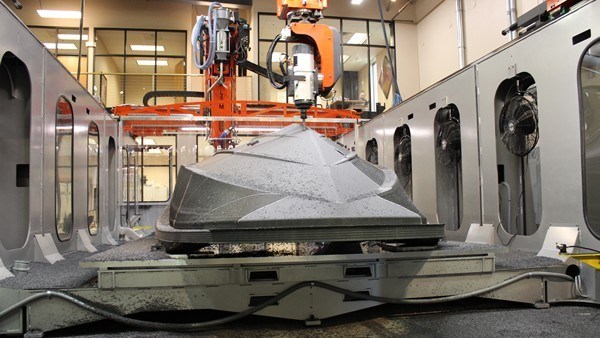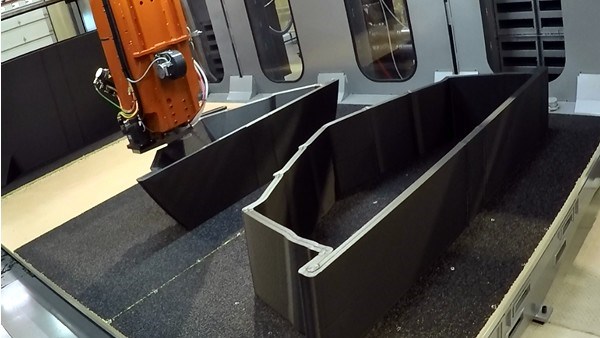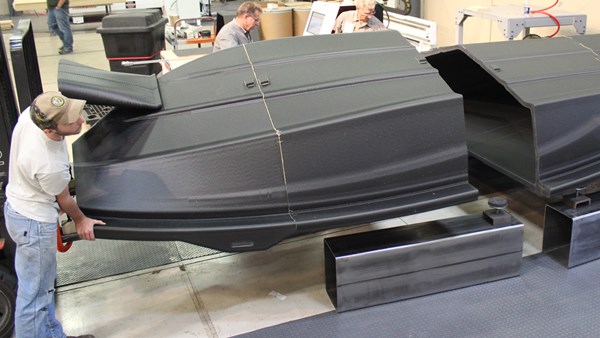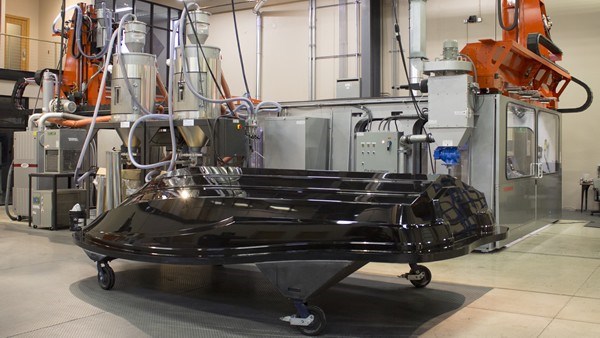Thermwood 3D prints large boat hull pattern
Thermwood uses its LSAM additive manufacturing technology to fabricate a 3,000-lb/1,363-kg plug for a boat hull. The project proves the viability of additive manufacturing to help reduce marine composites fabrication costs.

Thermwood LSAM machining boat hull pattern.
CNC and machining specialist Thermwood Corp. (Dale, IN, US) has 3D printed a boat hull pattern using a near net shape additive manufacturing process and then successfully used to produce a production-capable fiberglass mold in a proof-of-concept joint evaluation program.
This achievement was the result of a collaborative effort between Thermwood, masterbatch specialist Techmer PM (Clinton, TN, US) and mold specialist Marine Concepts/Design Concepts (Cape Coral, FL, US). The tool was printed slightly oversized and then trimmed to final size and shape using Thermwood’s large-scale additive manufacturing (LSAM) system.

Thermwood LSAM printing two of the six pattern sections.
The pattern was made from Techmer’s Electrafil ABS LT1 3DP, which Thermwood says has proven ideal for marine tooling applications when processed using LSAM print technology. The entire print, assembly and trim process required less than 10 working days to complete. After the printed and trimmed tool was coated and finished, a fiberglass mold was produced using the printed pattern.
The final tool was printed in six sections, including four major center sections with walls approximately 1.5 inches thick, and a solid printed transom and bow, which were pinned and bonded together using a Lord Corp. (Cary, NC, US) plural component urethane adhesive before being machined as a single piece on the Thermwood system. The final trimmed pattern weighs approximately 3,000 lb/1,363 kg and required approximately 30 hours to print and 30 hours to machine.

Assembly of boat hull pattern sections.
Thermwood’s demonstration machine, used for this program, has a 10-by-20-ft worktable and features print and trim capability on the same machine. The print head used for this project can print at rates approaching 200 lb/hr when running this particular Techmer material. Thermwood also offers larger machines and higher throughput print heads as part of its LSAM product line.
Thermwood says additive manufacturing offers the promise of even more advances in marine tooling, such as the potential to print the hull and deck pattern as a single piece, allowing a production mold to be taken from the hull and then flipping the pattern over and taking a deck mold from the other side of the same pattern. All of these possibilities result in dramatically lower tooling cost and substantially faster build time.
For large boats and yachts, Thermwood is evaluating the feasibility of printing molds directly, rather than printing a pattern from which the mold is taken. Because of their large size, such tools will need to be printed and machined in sections, even with very large LSAM printers. Also, it may also be possible to print integrated cooling channels for air or liquid into these large tools as part of the print process.

Finished, polished boat hull pattern.
Related Content
-
Revisiting the OceanGate Titan disaster
A year has passed since the tragic loss of the Titan submersible that claimed the lives of five people. What lessons have been learned from the disaster?
-
Plant tour: BeSpline/Addcomp, Sherbrooke, QC, Canada
Composites automation specialist increases access to next-gen technologies, including novel AFP systems and unique 3D parts using adaptive molds.
-
Pro-Set named official materials supplier for New York Yacht Club American Magic
Competitive sailing team prepares for the 37th America’s Cup beginning in August 2024 with adhesives, resins and laminate testing services for its AC75 monohull construction.
















